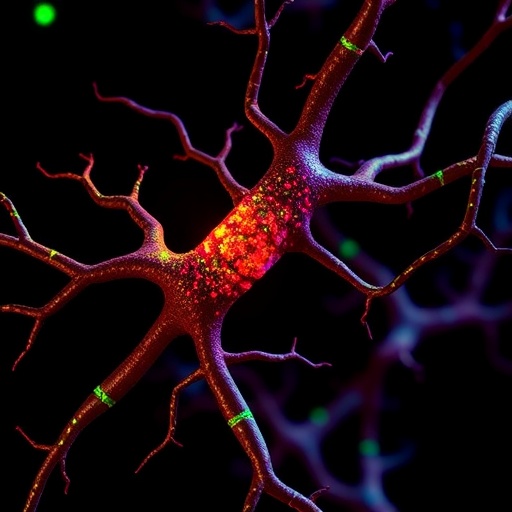In a groundbreaking study poised to reshape our understanding of pain biology, researchers have identified SLC45A4 as a crucial neuronal polyamine transporter with direct implications for pain perception. Utilizing advanced gene-editing techniques, the team generated homozygous knockout mice lacking the Slc45a4 gene, revealing profound insights into how this transporter regulates polyamine distribution within the nervous system and influences nociceptive processing.
Polyamines, including putrescine, spermidine, and spermine, serve as critical modulators of cellular growth and neural signaling. Measuring these within central and peripheral compartments revealed that the absence of Slc45a4 dysregulated polyamine homeostasis. Wild-type animals uniformly exhibited high polyamine levels in the brain, spinal cord, and dorsal root ganglia (DRG), but loss of the transporter selectively reduced spinal spermidine concentrations while elevating putrescine in DRG. These differential shifts underscore SLC45A4’s nuanced role in polyamine trafficking across neuronal populations.
.adsslot_ZVFGg9ImOX{width:728px !important;height:90px !important;}
@media(max-width:1199px){ .adsslot_ZVFGg9ImOX{width:468px !important;height:60px !important;}
}
@media(max-width:767px){ .adsslot_ZVFGg9ImOX{width:320px !important;height:50px !important;}
}
ADVERTISEMENT
Similarly, specialized mechanosensory structures, including NF200-positive lanceolate endings and CGRP-positive circumferential high-threshold mechanoreceptors, displayed normative morphology and density in knockout mice. These findings collectively confirm that SLC45A4’s primary contribution is functional, rather than structural, in sensory neurons and their peripheral terminals.
Given polyamines’ well-established involvement in cellular proliferation and differentiation, the lack of anatomical deficits despite altered polyamine distribution is particularly striking. This suggests a highly specific role for SLC45A4 in modulating the molecular pathways underlying pain sensation without affecting neuron development or maintenance. Such insights pave the way for targeted therapeutic interventions focusing on polyamine transport mechanisms.
Mechanistically, the study sheds light on how polyamine fluxes mediated by SLC45A4 could influence neuronal excitability and pain signaling. By controlling intracellular spermidine levels, SLC45A4 may regulate ion channel function, receptor sensitivity, or downstream signal transduction cascades critical for nociceptive processing. Aberrations in this finely tuned system could thus contribute to pain hypersensitivity or chronic pain states.
The translational implications of these discoveries are profound. Targeting SLC45A4-mediated pathways could offer novel analgesic strategies that circumvent many drawbacks associated with current pain medications. Rather than broadly suppressing neuronal activity, modulating polyamine transport might restore physiological pain thresholds with greater specificity and fewer side effects.
Moreover, the transient hair pigmentation phenotype observed in the knockout model hints at wider biological roles for polyamine transporters beyond the nervous system. Temporary disturbances in melanocyte function suggest SLC45A4’s involvement in developmental or regenerative processes, potentially linking polyamine metabolism to skin pigmentation disorders or other dermatological conditions.
Future research will undoubtedly focus on delineating the precise molecular interactions between SLC45A4, polyamines, and neuronal receptors implicated in pain. Elucidating these pathways at atomic and systems levels could unlock new frontiers in neurobiology and pharmaceutics, transforming how clinicians approach pain management.
This landmark study underscores the power of combining cutting-edge genetic engineering with rigorous biochemical and anatomical analyses to unravel previously obscure gene functions. SLC45A4 emerges not only as a key genetic determinant of pain but also as a nexus between metabolism and neuronal function, offering fresh perspectives on the complex interface regulating sensation.
As the field advances, understanding the nuanced roles of transporters like SLC45A4 in polyamine homeostasis promises to reshape foundational concepts in neuroscience and pain research. Ultimately, leveraging such knowledge may herald a new era of precision medicine addressing the pervasive challenge of debilitating pain worldwide.
Subject of Research: The role of SLC45A4 as a neuronal polyamine transporter influencing pain perception.
Article Title: SLC45A4 is a pain gene encoding a neuronal polyamine transporter.
Article References:
Middleton, S.J., Markússon, S., Åkerlund, M. et al. SLC45A4 is a pain gene encoding a neuronal polyamine transporter. Nature (2025). https://doi.org/10.1038/s41586-025-09326-y
Image Credits: AI Generated
Tags: cellular growth modulatorsCRISPR-Cas9 gene editingembryonic lethality in gene knockoutimplications for pain biologyknockout mouse modelneuronal polyamine transporternociceptive processing mechanismspain perception researchpolyamine distribution in nervous systempolyamine homeostasis disruptionSLC45A4 genetransient coat phenotype in mice





